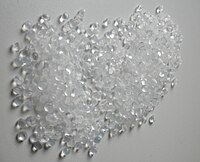
Photo from wikipedia
This research examines the impact of self-polymerized polydopamine (PDA) coating on the mechanical properties and microstructural behavior of polylactic acid (PLA)/kenaf fiber (KF) composites in fused deposition modeling (FDM). A… Click to show full abstract
This research examines the impact of self-polymerized polydopamine (PDA) coating on the mechanical properties and microstructural behavior of polylactic acid (PLA)/kenaf fiber (KF) composites in fused deposition modeling (FDM). A biodegradable FDM model of natural fiber-reinforced composite (NFRC) filaments, coated with dopamine and reinforced with 5 to 20 wt.% bast kenaf fibers, was developed for 3D printing applications. Tensile, compression, and flexural test specimens were 3D printed, and the influence of kenaf fiber content on their mechanical properties was assessed. A comprehensive characterization of the blended pellets and printed composite materials was performed, encompassing chemical, physical, and microscopic analyses. The results demonstrate that the self-polymerized polydopamine coating acted as a coupling agent, enhancing the interfacial adhesion between kenaf fibers and the PLA matrix and leading to improved mechanical properties. An increase in density and porosity was observed in the FDM specimens of the PLA–PDA–KF composites, proportional to their kenaf fiber content. The enhanced bonding between kenaf fiber particles and the PLA matrix contributed to an increase of up to 13.4% for tensile and 15.3% for flexural in the Young’s modulus of PLA–PDA–KF composites and an increase of up to 30% in compressive stress. The incorporation of polydopamine as a coupling agent in the FDM filament composite led to an improvement in tensile, compressive, and flexural stresses and strain at break, surpassing that of pure PLA, while the reinforcement provided by kenaf fibers was enhanced more by delayed crack growth, resulting in a higher strain at break. The self-polymerized polydopamine coatings exhibit remarkable mechanical properties, suggesting their potential as a sustainable material for diverse applications in FDM.
Journal Title: Polymers
Year Published: 2023
Link to full text (if available)
Share on Social Media: Sign Up to like & get
recommendations!